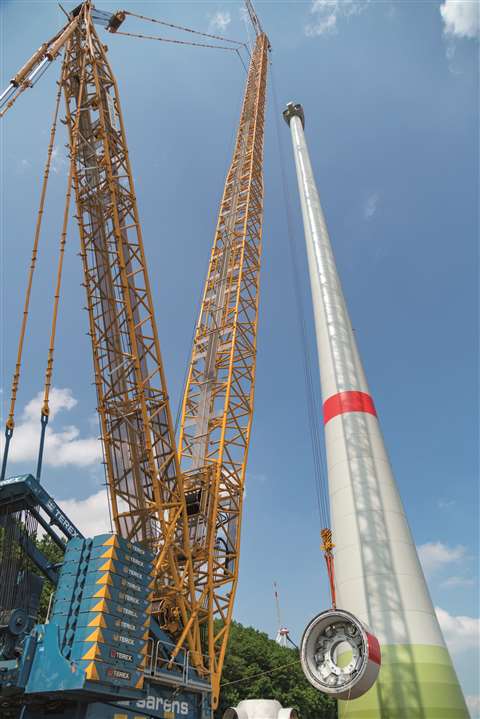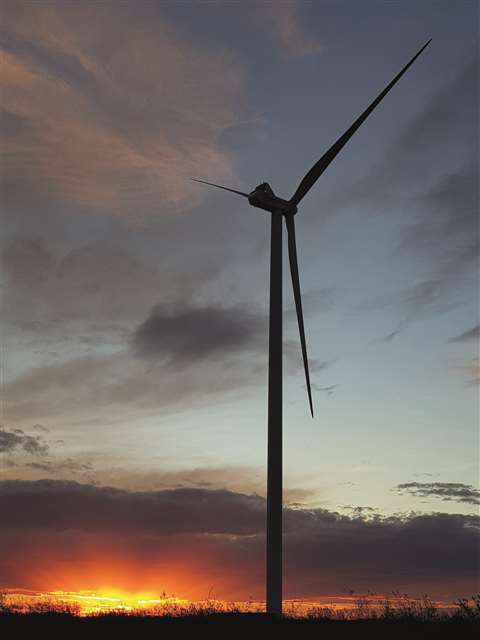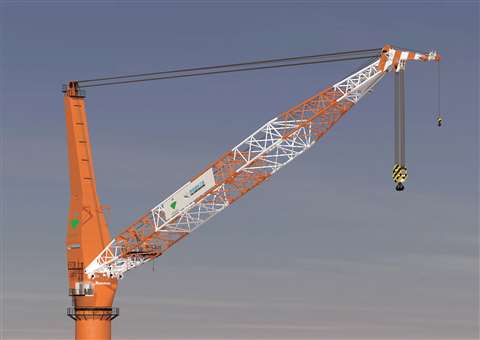Wind turbine transport and erection: Constant change
18 February 2019
With all the publicity surrounding the need to reduce carbon emissions and increase renewable energy, you’d be forgiven for thinking that the global wind market is flourishing. And in much of the world it is… but not everywhere. Much like the wind itself, the market fluctuates and in 2018 the German market lulled.
Until this year Germany had been a key wind market, providing a fruitful source of work for many transportation and lifting companies. Earlier in the year, however, the German government changed the way in which its onshore wind auctions worked so that bidding companies now need a permit. This, combined with additional permitting challenges, resulted in the latest German onshore wind auction being under-subscribed. In October 2018 the German Federal Network Agency, BNetzA, announced the results of the latest German onshore wind auction: only 363 MW of capacity won a contract, compared to the 670 MW on offer. More than 900 MW of projects were pre-approved for the auction and had a permit but only a third of these actually bid.
According to WindEurope, a Brussels-based association that promotes the use of wind power in Europe, the problem was that many wind farm companies faced legal challenges to their permits because regional siting plans (that determine the location of wind farms) are not as robust as they should be, potentially exposing wind farm companies to penalties for non-delivery.
Compounding the problem, it also became harder to get permits for new wind farms in Germany. According to Wind Europe, two years ago it took 300 days; now it takes up to 700 days.
WindEurope CEO Giles Dickson said, “The German government was right to change the auction rules so that wind farms now need a permit before they can bid. But it’s got harder to get a permit. And even when you get one, you’re exposed to legal challenges because the regional siting plans are not robust enough. Germany needs to address this otherwise the auctions will continue to be under-subscribed like this last one. And the prices will be higher than they should be.
“This adds to the uncertainty already facing wind in Germany, with the coalition still failing to define the auction volumes for the coming years. The wind industry is already laying people off in Germany. The government has got to sort things out fast.”
Rise and fall
This sentiment was echoed by wind specialist Mariusz Sudol, who – along with Benjamin Noé – heads up the dedicated wind division of international heavy lift and transportation specialist Sarens. A year ago Sarens set up its dedicated wind division with the aim of better serving its clients in the wind sector.

“It’s been a terrible year for wind-related work in Germany,” laments Sudol. “We were counting on the market in Germany being strong but, because of the change in permit law, the market has died. The wind market is fast-moving and the difficulty is that it is not constant – it changes year to year. One year you can have lots of work in one country and then the next, nothing. For example, in 2014/15 we were very busy in Poland, assembling almost 200 units per year. Then, in 2016/17, this dropped to just one or two units per year. In Germany we were very busy, with 20 lattice boom cranes working there; now, since the second half of 2018, we don’t have any there at all.
“We cannot predict what will happen or afford to keep all our cranes in one country, so we really need to focus and keep on top of what is happening in the wind market. We know, for example, that Norway and the Scandinavian countries will be busy, so we’ve now transferred lots of our cranes there.”
In addition, the Spanish market is currently proving to be a good source of work for Sarens. “We’ve had some really big orders from Spain,” Sudol said. “Next year we will be working for Siemens Gamesa Renewable Energy and we’ll have around 40 to 50 cranes out in Spain. We are also working for General Electric, together with Fairwind, on a large project involving 81 wind turbines in Spain. In addition, we are doing lots of smaller jobs in France, Belgium and Holland.”
Sudol says Sarens has also been working in Australia, Africa, Vietnam, Serbia. “And next year we will be very focused on Russia and the Ukraine,” he adds. “We are also trying to reach developing markets that other heavy lift companies don’t go to rather than just sticking to established markets.” He cites Sarens’ work in Mauritania and South Africa as being good examples of this.
With such a widespread and fluctuating client base Sudol stresses the importance of being prepared. “We are very well-equipped with new cranes right now. For example, we have two 750 tonne lattice boom LG1750 SX cranes. One is in Australia, and the other is based in Poland, although it is currently working in Norway for Vestas.
“We also have a Demag PC 3800-1 pedestal crane which is the pedestal version of the 650 tonne capacity CC 3800-1 lattice boom crawler crane. It was developed by Terex Demag in close co-operation with Sarens.” According to Sarens, the Demag PC 3800-1 offers improved crane capacity, especially on the main boom, and there is less need for extensive ground preparation since it can level itself on outriggers.
Sarens has also established a presence in Taiwan with its newly formed Sarens in Taiwan offshoot. According to the company, Sarens in Taiwan is positioned to make the most of the Taiwanese government‘s policy on offshore wind energy, which is generating growth opportunities. The government of Taiwan will be awarding a total of 10.5 GW in grid capacity for offshore wind contracts, and is already on track to add 4.066 MW of offshore wind power by 2025, Sarens claims. To meet new development needs, Sarens in Taiwan will maintain a fleet of SPMT, SGC-120s, SGC-90s, and CC 8800s and will provide onshore logistics for offshore projects.
In China, a joint venture between Sarens and Chinese state-owned logistics company Sinotrans has resulted in one of the larger cranes in Sarens’s fleet, the 1,600 tonne capacity CC 8800-1, plus a Boom Booster kit, being transported over there, along with its CC 6800 crane. Sarens says that the two cranes will be available for a range of work, including offshore wind farm operations.
Despite having such an extensive fleet, Sudol says Sarens is also looking to develop its fleet further. “We are currently considering buying more cranes specifically for the wind market,” Sudol concludes.
“In particular, we are looking at buying crawler and truck cranes.” And despite the sudden decline of wind work in Germany, the fluctuating nature of the market means Sudol remains positive: “We will be back working there very soon, I hope.”
Netherland-based international heavy lift and transport specialist Mammoet is also expanding its presence to better serve the wind market. It remains undeterred by the decline in the German market. On 13 December 2018, the company opened a new office in Hamburg – a city which it says is home to most of its customers in the wind industry. Mammoet Germany said the new office will allow it to expand and improve its offerings to the North German market.
Australian market
Australia is also an important wind market for Mammoet. In September 2018 it signed a contract with Goldwind Australia, a subsidiary of Chinese wind turbine manufacturer Goldwind, for a multi-year framework agreement with all contract terms and conditions agreed upfront, providing Goldwind Australia the option to select Mammoet for its future wind farms in Australia.
Mammoet has already installed a project team in Melbourne to commence operations. The first projects planned will comprise erecting a total of 253 Goldwind wind turbine generators in Victoria.
For the purpose of this agreement, Mammoet says it has extended its Australian crane fleet with two new 750 tonne capacity Liebherr LG 1750-SX cranes. According to Mammoet operations manager Riki McMahon, the LG 1750 is an ideal crane to work with the new generation of higher and more powerful wind turbines. “The addition of these cranes ensures we are equipped for the future developments and demands of the market,” he says.
Further investments will be made in all terrain support cranes, trucks, trailers and auxiliary equipment, the company adds.

El Llano wind farm
Remaining in the Southern Hemisphere, heavy lifting and transportation company ALE reports it has provided the full-service package for the El Llano wind farm in Argentina. The job comprised the discharge and port handling, transport, assembly, and electro-mechanical installation of 14 wind turbines comprising 154 components.
ALE received the wind components at Puerto Madryn, in Patagonia. They were then transported to site using a selection of trailers. ALE used 36 conventional axle lines and two spacers, three extendable semi-trailers plus two trailers of different capabilities. For the discharge on site, ALE provided several cranes, ranging from 95 to 250 tonnes capacity. For the installation and assembly scope, ALE positioned a Liebherr LR 1600 W/2 crawler as the main crane, along with Liebherr LTM 1500 and LTM 1250 mobile cranes, as well as an LTM 1095 mobile crane for the assembly of the T1 and T2 sections and for support activities.

ALE provided the full-service package for the El Llano wind farm in Argentina
Areas of innovation
Offshore, ALE has been busy, too. ALE completed work on the H2020 Elican project off the coast of Gran Canaria led by Spanish civil engineering and architecture firm Esteyco. The job involved creating a bespoke solution for installation of what ALE calls ‘the world’s first self-installing telescopic offshore wind turbine’.
According to ALE, it was a complex project that involved a lot of co-ordination with other parties so planning began almost two years before the first test lifts were carried out.
To reduce risk and increase safety on the project, ALE’s R&D department and Esteyco developed a wi-fi controlled horizontal guidance system that enabled the manoeuvres to be performed remotely, from a boat located away from the tower.
From March to April 2018 ALE performed test lifts of the T2 section, weighing 240 tonnes, then the T1 section, weighing 360 tonnes, both measuring 33 m high. Then ALE’s new horizontal guidance system was used to perform the lifting of the T2 section with nacelle, weighing 540 tonnes.
The final offshore installation took place two months later. This phase involved the lowering of the gravity base structure and transportation, installation and maintenance platform from the port of Arinaga, Gran Canaria, to the Plataforma Oceánica de Canarias.
ALE performed the final lifting of the T1 and T2 sections with nacelle, weighing 960 tonnes, in July 2018. According to ALE, this lifting manoeuvre avoided the need for costly crane vessels by using strand jacks and the new horizontal guidance system. ALE says it also developed a new type of galvanised strands for the project, which have greater resistance to the corrosion that can be encountered on offshore projects, as well as a new recoiler design to work within the limited space. This rolls over the unit and eliminates the need for the strand guide, ALE explains.
“In co-ordination with Esteyco, we have developed specific solutions for all the challenges resulting from the project and reduced risk thanks to our engineering designs. This project has really demonstrated our capabilities in the renewables sector and the confidence our clients have in our innovative methodologies for us to carry out more projects involving these types of towers, both in offshore and onshore,” said Cecilio Barahona, project engineer at ALE’s Spanish branch.
Self erecting prototype
Onshore, another bespoke engineering solution ALE provided was to heighten the prototype of one the world’s highest wind towers: the Nabralift self erecting tower.
The job also involved transportation of the 450 tonne wind tower, in Navarra, Spain. The Nabralift self erecting tower, designed by Spanish wind turbine component manufacturer Nabrawind Technologies, stands 160 m high.
According to ALE, Nabrawind is working on developing solutions for installation of wind towers without the use of cranes, whatever the hub height. According to Nabrawind, by negating the need for specialist assembly equipment, the cost of installation can be reduced.
To transport the wind tower, ALE used 12 SPMT axle lines. Once in position, it used three strand jack units to heighten it.
“It is fantastic to have been given the opportunity to work on this unique project and showcase our capabilities within the onshore wind market,” commented ALE project engineer David Arias Blanco. “Recognising our track record in Spain, the client was confident we could supply the complex solution necessary. By providing this customised solution, our client can now have the means of developing onshore wind farms in the most cost- and time-effective method possible.
“This is game-changing technology, specifically for those located on difficult-to-reach islands or mountainous sites. From our findings, we are already developing engineering processes to fulfil the requirements of future large-scale installations with an aim to develop two towers a week.”
The project was completed in September 2018 and ALE said discussions are ongoing regarding future use of this prototype and methodology. A video of the heightening work is at: www.nabrawind.com/nabralift.
These examples demonstrate that although the winds of fortune are not currently favouring the German market, there are plenty of new markets growing, leading to continued innovation within the wind sector.
Big Huisman crane for Japan
Japan Marine United Shipyard (JMU) has ordered a 1,000 tonne capacity crane from Dutch specialist Huisman. The pedestal mounted crane will be used for offshore wind turbine installation in Japan. It will be built at Huisman’s yard in China and installed at the JMU yard in Japan.
The latest order for Japan follows another two years ago. Huisman supplied an 800 tonne pedestal crane for the Japanese Penta-Ocean Construction company’s self-elevating platform. It was also constructed by JMU and used to install offshore wind turbines.
The end clients for the latest crane vessel are Japanese construction companies Obayashi Corporation and TOA Corporation. It was the first firm order, Huisman said, since it began working with Japanese agent Exeno Yamamizu Corporation.
While the design of the crane “builds on the track record of Huisman’s previous crane for the Japanese market,” it will be adapted to suit Obayashi Corporation and TOA Corporation, Huisman said.





